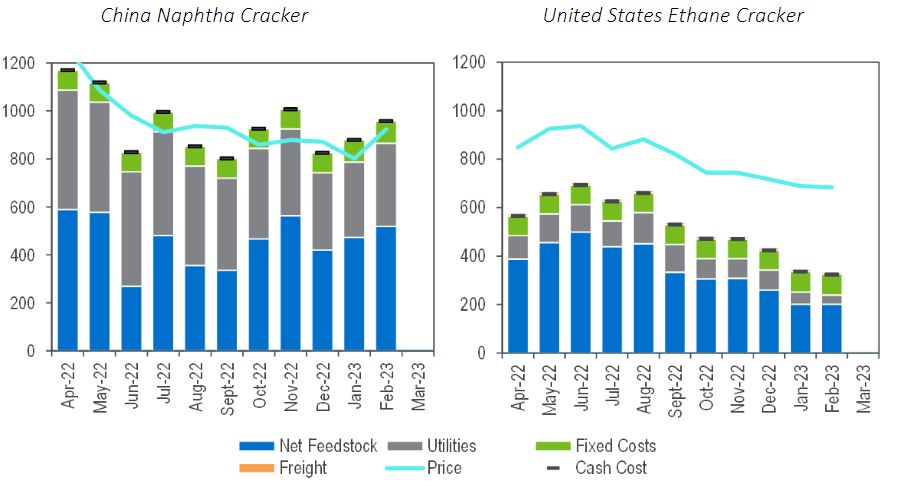Petrochemicals and polymers: Quarter one performance

Persistently weak petrochemical markets hinder recovery of profitability as immense burden of energy costs moderates into opening months of 2023
Profitability of many sectors of petrochemical industry opened 2023 at lower end of historic range, facing consistent pressure from a harsh operating environment over previous year. A sharp increase in crude oil prices initially deepened cost pressure as emerging conflict in Ukraine risked supply. Brent crude oil prices peaked at a 10 year high in June after increasing 70 percent through first half of the year. Intense cost pressure headed by escalation of global energy values soon took its toll on demand and a deteriorating global economic climate weakened petrochemical markets appreciably through the second half of the year. Depressed co-product revenue offset feedstock cost savings offered by naphtha as crude oil prices moderated through the second half of the year. Naphtha crackers in Asia offered a steady production cost base for ethylene and margins narrowed to variable cost breakeven as prices fell to a floor in January.
Global gas prices lagged the downturn in oil prices until demonstration of sufficient inventory through the winter led prices to fall heavily into January. Elevated gas prices held the cost of ethylene from cracking ethane in the United States above $450 per ton for more than a year for the first time in a decade. Weakening domestic markets closely aligned prices in The United States with the downturn in Asian prices delaying recovery of margins from the historic lows suffered through the middle of the year.
Ethylene Production Costs ($/ton)
Petrochemicals and Polymers: Quarter One Performance Q1 2023
Demonstration of sufficient inventory through the winter led gas costs to fall heavily into 2023. Naphtha faced contrasting cost pressures as concentrated demand growth on resumption of normal production operations in China led costs to escalate ahead of crude oil. The recently published NexantECA Quarterly Business Analysis report addresses current trends in cost, price, and margin. Renewed cost competitiveness of feedstocks derived from gas was a key theme in continued turbulent operating environment through opening quarter of 2023.
Suspension of zero COVID-19 policy in China offered little relief to frail margins as feedstock costs rebounded ahead of petrochemical prices. Oversupplied markets confined profitability to historic lows
Hopes of a brisk recovery in demand as China suspended zero COVID-19 policy were stalled by a more cautious attitude from buyers who preferred to await a clearer picture of market trends. Demand across principal sectors including construction, automotive and consumer goods remained subdued, with deteriorating confidence in the economic climate delaying discretionary consumer spending. Consumers were less active in spot markets, buying on a need-to basis. Widespread factory shutdowns around The Lunar New Year holiday kept demand subdued in January. Pick up of activity in February fell short of expectations as confidence in a turbulent global economic climate deteriorated.
A renewed upturn in prices was largely driven by firming feedstock costs rather than being indicative of strengthening markets. Ethylene prices in China bottomed out at a 30 month low in January. Restoration of production operations in China led to a concentrated upturn in demand for naphtha that restored more typical crack spreads to crude oil. Ethylene prices in China posted strongest increase for a year in February, gaining more than $120 per ton from January. Chronic oversupply confined margins of naphtha crackers in China close to cash cost breakeven after bottoming out at historic lows near variable cost breakeven in January.
Relaxing energy cost burden in Europe failed to revive petrochemical margins as naphtha costs rebounded on resumption of operations in China. Profitability fell to ten year low in weak demand constrained markets.
Commodity petrochemical markets in Western Europe remain burdened with fragile demand as elevated inflation rates, interest rates and energy costs promote caution in discretionary consumer spending. Volumes are heavily down on the year despite indications of improving sentiment into 2023 as the critical pinch in global energy markets showed signs of relaxing. Supply of base petrochemicals lengthened as crackers halted for extended outages in closing months of 2022 restarted by February. High fuel values and resilient gasoline demand limited extraction into petrochemical markets where fragile demand offered lower value. Lengthening domestic supply was countered by moderation of imports as Cargoes were directed to an expected upturn in Asia as China fully reopened to business. Disciplined production management held commodity petrochemical markets in Western Europe in a balanced to long position.
A sharp downturn in gas prices from record highs posted in October offered some optimism to European markets. The steep upturn in crude oil prices built to supply side risk as the conflict in Ukraine emerged a year ago was cleared by start of 2023 and Brent Crude oil prices stagnated with markets seeking direction. Moderation of global energy values was not apparent in petrochemical feedstock costs. Production costs faced renewed pressure as naphtha prices rebounded to a seven month high above US$700 per ton in February. Weak markets capped price initiatives against firming costs. Average margins tumbled 35 percent to settle near a ten year low. Strong gains built emerging from the COVID-19 pandemic into 2021 have been entirely surrendered.
Petrochemical profitability in U.S. firmed from floor found ending 2022 as cost competitiveness of feedstocks derived from gas returned. Subdued domestic demand in harsh economic climate limited cost led upturn.
Weak domestic demand remained a heavy burden for petrochemical markets in United States as consumer confidence was heavily depressed. The Federal Reserve has led tightening fiscal policy to reign in stubbornly elevated inflation rates, but pace of interest rate rises has strained economic activity as consumers adopt cautious discretionary spending. The sharp drop in gas costs lent little support to domestic demand.
Export demand provided some relief to markets as a more typical cost advantage was restored in the United States. Gas prices dropped 75 percent from a peak towards the middle of 2022 and settled below US$2.5 per mmBTU in February for first time in two years. Naphtha prices elsewhere escalated alongside reopening of business in China. Profitability reflected weak domestic demand and saw little upturn from the lower cost base. Average margins across the petrochemical industry firmed 20 percent from the 20 year low suffered at the end of 2022. Weak domestic demand continues to heavily cap margins and thin profitability settled close to that achieved as COVID-19 disturbed markets in first half of 2020.
Weakness engrained in export markets limited opportunity to add value to cost advantaged feedstocks in The Middle East confining profitability of exports to a 20 year low.
Profitability of exports from Middle East rolled over into opening quarter of 2023 holding margins at the twenty year low (excluding COVID-19 distressed markets in 2020) found in the second half of 2022. Cost advantage of feedstocks derived from low cost gas diminished as average oil prices retreated to lowest for a year. Suspension of zero COVID-19 policy in China failed to deliver an anticipated upturn in profitability in Asian markets and margins remained absent as market sentiment swiftly reverted to downside risk of oversupply. Slack demand in Europe similarly depressed margins as consumers reacted cautiously to harsh economic climate.
Find out more...
Quarterly Business Analysis: Global - Petrochemicals, Polymers and C1 Chemicals - Q1 2023
The Quarterly Business Analysis provides key insight into production economics for a broad range of commodity petrochemicals, polymers and C1 chemicals. The analysis presents a review of costs, prices and margins for typical production assets, providing a valuable view of regional and value chain competitiveness and is is available for each key price setting region - Asia Pacific, Middle East, Western Europe and the United States. A quarterly report provides insightful commentary to illustrate current trends, related to recent market developments. The accompanying database is updated monthly.
UPCOMING WEBINAR...
In this 45 minute webinar, NexantECA will present its views on the industry performance during the first quarter of 2023, as well as summarise how petrochemical production economics have reacted, sourcing material from the Quarterly Business Analysis reports.
Wednesday, April 19, 2023 @ 9AM BST
Duration: 45 minutes
Wednesday, April 19, 2023 @ 2PM BST
Duration: 45 minutes
About the Presenter...
Andrew Powell, Project Manager
Andrew has 20 years of experience analysing petrochemical industry performance with NexantECA. He is an expert in assessing production economics and preparing price forecasts spanning the full petrochemical industry value chain, from refinery to specialty chemicals. Andrew leads development of NexantECA Subscriptions analysis of profitability and pricing across the global petrochemical industry.
Andrew Powell - NexantECA Q1 2023

